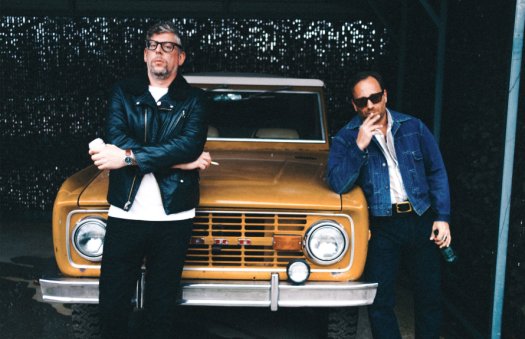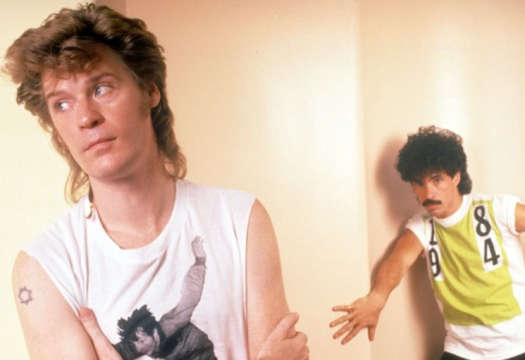For this month's issue of Exclaim!, it felt wrong to write our regular Timeline feature on any other artist than David Bowie, from whose recent passing we're still reeling. From his canonical '70s discography to his masterful swan song Blackstar, Bowie influenced both the music world and pop culture in general, thumbing his nose at convention and being an early adopter of new genres and cultural movements whenever he could.
Bowie's full story is told across three colourful pages in our new issue, and it will be online shortly, but in the meantime, we've pinpointed ten fascinating details from the annals of Bowie's far-reaching career below.
Ten Noteworthy Facts You May Not Know About David Bowie:
1. Bowie was probably one of the first people to hear The Velvet Underground & Nico — ever.
In 1966, Bowie's manager Kenneth Pitt travels to New York to speak with Andy Warhol about representing his then-unknown new group, the Velvet Underground, and returns with an acetate of the unreleased The Velvet Underground & Nico, which he gives to Bowie. Bowie later writes that the listening experience "was shattering. Everything I both felt and didn't know about rock music was opened to me on one unreleased disc... The first track glided by innocuously enough and didn't register. However, from that point on, with the opening, throbbing, sarcastic bass and guitar of 'I'm Waiting for the Man,' the linchpin, the keystone of my ambition was driven home. This music was so savagely indifferent to my feelings. It didn't care if I liked it or not. It could give a fuck. It was completely preoccupied with a world unseen by my suburban eyes."
2. Bowie and Tony Visconti may just have invented glam rock — in 1970.
Bowie, Mick Ronson and Visconti set about converting part of the space into a rehearsal and recording studio where the foursome — Bowie, Ronson, Visconti and John Cambridge — rehearse and exchange ideas constantly; Angie Bowie [David's wife] manages schedules, offers feedback, makes costumes and keeps the house running smoothly.
They call their band the Hype and each assume characters: Bowie is Rainbow Man, Visconti is Hype Man, Ronson is Gangster Man and Cambridge is Cowboy Man. Visconti will later recall their debut gig — where they play a mix of Space Oddity cuts and material that will appear on the gestating The Man Who Sold the World — as "the very first night of glam rock. Marc Bolan was visible resting his head on his arms on the edge of the stage, taking it all in. Bolan never admitted he even went to the gig."
3. Bowie almost died in Toronto rehearsing for his Diamond Dogs tour, an all-out theatrical affair that changed concert history.
RCA provides a huge budget for the tour, based on Bowie's rising star and the insane demand for a tour. American fans will be presented with his most extravagant show yet: It will feature a theatrical set of a city, complete with streetlights, towers and a bridge that moves up and down, featuring brakes designed by Porsche. The bridge is shipped to Toronto to be tested during tour rehearsal in early 1974 where, one night, it suddenly falls 15 feet with Bowie on it; though the production team is frightened, he's unharmed. News of the tour is released to the public in the spring.
The Diamond Dogs tour kicks off in Montreal on June 14, and it's an impressive affair: when Bowie first appears, he's seated on a giant hand; he never addresses the audience, or mentions the city he's in; there are no breaks between songs; during "Cracked Actor," he sings to a skull, Hamlet-style, and dons boxing gloves for "Panic in Detroit"; he leaves without taking a bow. It's a spectacle mostly unseen in pop and rock performance, setting a new precedent for the potential of concert tours.
4. Bowie discovered Luther Vandross.
During recording sessions, Carlos Alomar brings in his old high school classmate, an then-unknown singer named Luther Vandross, to contribute to the recording of the song "Young Americans"; Vandross suggests that it needs backing vocals, and Bowie is impressed by his instincts. The two co-write a song called "Fascination" for Young Americans.
"It was the first time that I ever had someone of his stature be encouraging," Vandross will tell Marc Spitz in Bowie: A Biography. "[Bowie] was constantly telling me, 'You've got to stick with this. You're going to make it.'"
5. In 1975, at the height of his cocaine psychosis, Bowie thought witches were after his semen.
In April, he leaves New York for Los Angeles, staying at the house of Deep Purple bassist Glenn Hughes, who spends most of the year on the road. Left to his own devices, the paranoid Bowie, who's stopped going out entirely, has stashed all of the kitchen knives and sharp objects under the bed. He's reading Psychic Self-Defense and books about Aleister Crowley, the Nazis and Kirlian, a type of photography that allegedly captures one's aura; his only visitors are couriers, drug dealers and groupies.
When Bowie becomes certain that there are witches after his semen, with the goal of making a child to sacrifice to the devil, he reaches out to a famous witch named Walli Elmlark, a teacher at the New York School of Occult Arts and Sciences who has given spiritual guidance to rock stars such as Jimi Hendrix. In L.A., Elmlark exorcises the pool — Angie, who came to visit when Bowie called her in a cocaine-induced panic, will later swear that the pool bubbled and smoked — and writes out spells for Bowie to use should the spirits return.
6. Bowie and Frank Sinatra became pals and helped each other record.
In 1975, when Frank Sinatra comes to Cherokee Studios to begin recording what would either become his 1980 comeback album Trilogy (or possibly Christmas songs, depending on the source), he and Bowie hit it off; Bowie contributes harmony to one of Sinatra's tracks, and when Sinatra approves of Bowie's "Wild Is the Wind" cover, Bowie decides to make it the final track of his forthcoming album, Station to Station.
7. Bowie cared about music videos before they were cool.
Lodger is released on May 18, 1979, along with promotional videos for "Boys Keep Swinging," "D.J." and "Look Back in Anger." In the pre-MTV era, few artists dedicate time or money to the music video format, but Bowie's ahead of his time: "Boys Keep Swinging" features three female backups singers (three Bowies, all in drag); "D.J." finds Bowie walking through public streets as the camera rolls, with fans mobbing him and kissing him as he sings.
8. "Bowie Night" was a thing was before Bowie's passing, and Mick Jagger wasn't allowed in.
With the freaks and weirdos being pushed out of punk by violence skinheads and National Front supporters, New Romanticism takes off. Steve Strange, of New Romantic band Visage, founds "Bowie Night" at Billy's Club, where the DJs play Bauhaus, Nina Hagen, Brian Eno, Kraftwerk and more.
The event becomes so huge that eventually it's moved to the Blitz Club, where Strange works the door and enforces a strict no-norms policy that tightens further when publicity for turning away a drunken Mick Jagger makes the lines even longer. When Bowie shows up at the club one night, he asks Strange to round up four people to appear in his music video for forthcoming single "Ashes to Ashes."
9. Bowie was almost the second victim of Mark David Chapman, John Lennon's killer.
After rehearsing all summer, Bowie draws from his early mime and theatre experience to play John Merrick in a stage play of The Elephant Man from autumn until the end of the year. Bowie's nearly unrecognizable onstage, committing fully to the part; critics praise his captivating performance, and between the reviews and word of moth, the theatrical run quickly sells out.
When Mark David Chapman is apprehended after murdering John Lennon on December 8, a program for The Elephant Man is found among his belongings, along with a photo he'd taken of Bowie; Chapman would later claim that he had plans to kill Bowie, who was second on his list after Lennon, and Bowie tightens his security. Shaken, he returns to Switzerland in January of 1981.
10. On tour, Bowie and Nine Inch Nails played a four-song transitional set between their opening and headlining set.
Bowie invites Nine Inch Nails to open the first leg of the Outside Tour in 1995. Trent Reznor is initially reluctant to meet his hero, but eventually agrees, and the two become peers. Bowie and Reznor agree to eschew show intermissions in favour of a four-song segue that slowly transitions from one set into the next: Bowie comes out and plays "Scary Monsters" backed by Nine Inch Nails; Reznor and Bowie sing the openers' "Reptile" together; the curtain rises to reveal Bowie's band, who accompany NIN on Bowie's "Hallo Spaceboy"; then, NIN leave the stage, and Bowie's band backs Reznor and Bowie on "Hurt"; Bowie continues alone from there.
Bowie's full story is told across three colourful pages in our new issue, and it will be online shortly, but in the meantime, we've pinpointed ten fascinating details from the annals of Bowie's far-reaching career below.
Ten Noteworthy Facts You May Not Know About David Bowie:
1. Bowie was probably one of the first people to hear The Velvet Underground & Nico — ever.
In 1966, Bowie's manager Kenneth Pitt travels to New York to speak with Andy Warhol about representing his then-unknown new group, the Velvet Underground, and returns with an acetate of the unreleased The Velvet Underground & Nico, which he gives to Bowie. Bowie later writes that the listening experience "was shattering. Everything I both felt and didn't know about rock music was opened to me on one unreleased disc... The first track glided by innocuously enough and didn't register. However, from that point on, with the opening, throbbing, sarcastic bass and guitar of 'I'm Waiting for the Man,' the linchpin, the keystone of my ambition was driven home. This music was so savagely indifferent to my feelings. It didn't care if I liked it or not. It could give a fuck. It was completely preoccupied with a world unseen by my suburban eyes."
2. Bowie and Tony Visconti may just have invented glam rock — in 1970.
Bowie, Mick Ronson and Visconti set about converting part of the space into a rehearsal and recording studio where the foursome — Bowie, Ronson, Visconti and John Cambridge — rehearse and exchange ideas constantly; Angie Bowie [David's wife] manages schedules, offers feedback, makes costumes and keeps the house running smoothly.
They call their band the Hype and each assume characters: Bowie is Rainbow Man, Visconti is Hype Man, Ronson is Gangster Man and Cambridge is Cowboy Man. Visconti will later recall their debut gig — where they play a mix of Space Oddity cuts and material that will appear on the gestating The Man Who Sold the World — as "the very first night of glam rock. Marc Bolan was visible resting his head on his arms on the edge of the stage, taking it all in. Bolan never admitted he even went to the gig."
3. Bowie almost died in Toronto rehearsing for his Diamond Dogs tour, an all-out theatrical affair that changed concert history.
RCA provides a huge budget for the tour, based on Bowie's rising star and the insane demand for a tour. American fans will be presented with his most extravagant show yet: It will feature a theatrical set of a city, complete with streetlights, towers and a bridge that moves up and down, featuring brakes designed by Porsche. The bridge is shipped to Toronto to be tested during tour rehearsal in early 1974 where, one night, it suddenly falls 15 feet with Bowie on it; though the production team is frightened, he's unharmed. News of the tour is released to the public in the spring.
The Diamond Dogs tour kicks off in Montreal on June 14, and it's an impressive affair: when Bowie first appears, he's seated on a giant hand; he never addresses the audience, or mentions the city he's in; there are no breaks between songs; during "Cracked Actor," he sings to a skull, Hamlet-style, and dons boxing gloves for "Panic in Detroit"; he leaves without taking a bow. It's a spectacle mostly unseen in pop and rock performance, setting a new precedent for the potential of concert tours.
4. Bowie discovered Luther Vandross.
During recording sessions, Carlos Alomar brings in his old high school classmate, an then-unknown singer named Luther Vandross, to contribute to the recording of the song "Young Americans"; Vandross suggests that it needs backing vocals, and Bowie is impressed by his instincts. The two co-write a song called "Fascination" for Young Americans.
"It was the first time that I ever had someone of his stature be encouraging," Vandross will tell Marc Spitz in Bowie: A Biography. "[Bowie] was constantly telling me, 'You've got to stick with this. You're going to make it.'"
5. In 1975, at the height of his cocaine psychosis, Bowie thought witches were after his semen.
In April, he leaves New York for Los Angeles, staying at the house of Deep Purple bassist Glenn Hughes, who spends most of the year on the road. Left to his own devices, the paranoid Bowie, who's stopped going out entirely, has stashed all of the kitchen knives and sharp objects under the bed. He's reading Psychic Self-Defense and books about Aleister Crowley, the Nazis and Kirlian, a type of photography that allegedly captures one's aura; his only visitors are couriers, drug dealers and groupies.
When Bowie becomes certain that there are witches after his semen, with the goal of making a child to sacrifice to the devil, he reaches out to a famous witch named Walli Elmlark, a teacher at the New York School of Occult Arts and Sciences who has given spiritual guidance to rock stars such as Jimi Hendrix. In L.A., Elmlark exorcises the pool — Angie, who came to visit when Bowie called her in a cocaine-induced panic, will later swear that the pool bubbled and smoked — and writes out spells for Bowie to use should the spirits return.
6. Bowie and Frank Sinatra became pals and helped each other record.
In 1975, when Frank Sinatra comes to Cherokee Studios to begin recording what would either become his 1980 comeback album Trilogy (or possibly Christmas songs, depending on the source), he and Bowie hit it off; Bowie contributes harmony to one of Sinatra's tracks, and when Sinatra approves of Bowie's "Wild Is the Wind" cover, Bowie decides to make it the final track of his forthcoming album, Station to Station.
7. Bowie cared about music videos before they were cool.
Lodger is released on May 18, 1979, along with promotional videos for "Boys Keep Swinging," "D.J." and "Look Back in Anger." In the pre-MTV era, few artists dedicate time or money to the music video format, but Bowie's ahead of his time: "Boys Keep Swinging" features three female backups singers (three Bowies, all in drag); "D.J." finds Bowie walking through public streets as the camera rolls, with fans mobbing him and kissing him as he sings.
8. "Bowie Night" was a thing was before Bowie's passing, and Mick Jagger wasn't allowed in.
With the freaks and weirdos being pushed out of punk by violence skinheads and National Front supporters, New Romanticism takes off. Steve Strange, of New Romantic band Visage, founds "Bowie Night" at Billy's Club, where the DJs play Bauhaus, Nina Hagen, Brian Eno, Kraftwerk and more.
The event becomes so huge that eventually it's moved to the Blitz Club, where Strange works the door and enforces a strict no-norms policy that tightens further when publicity for turning away a drunken Mick Jagger makes the lines even longer. When Bowie shows up at the club one night, he asks Strange to round up four people to appear in his music video for forthcoming single "Ashes to Ashes."
9. Bowie was almost the second victim of Mark David Chapman, John Lennon's killer.
After rehearsing all summer, Bowie draws from his early mime and theatre experience to play John Merrick in a stage play of The Elephant Man from autumn until the end of the year. Bowie's nearly unrecognizable onstage, committing fully to the part; critics praise his captivating performance, and between the reviews and word of moth, the theatrical run quickly sells out.
When Mark David Chapman is apprehended after murdering John Lennon on December 8, a program for The Elephant Man is found among his belongings, along with a photo he'd taken of Bowie; Chapman would later claim that he had plans to kill Bowie, who was second on his list after Lennon, and Bowie tightens his security. Shaken, he returns to Switzerland in January of 1981.
10. On tour, Bowie and Nine Inch Nails played a four-song transitional set between their opening and headlining set.
Bowie invites Nine Inch Nails to open the first leg of the Outside Tour in 1995. Trent Reznor is initially reluctant to meet his hero, but eventually agrees, and the two become peers. Bowie and Reznor agree to eschew show intermissions in favour of a four-song segue that slowly transitions from one set into the next: Bowie comes out and plays "Scary Monsters" backed by Nine Inch Nails; Reznor and Bowie sing the openers' "Reptile" together; the curtain rises to reveal Bowie's band, who accompany NIN on Bowie's "Hallo Spaceboy"; then, NIN leave the stage, and Bowie's band backs Reznor and Bowie on "Hurt"; Bowie continues alone from there.




